Announcement
Collapse
No announcement yet.
Portable Rock Art Petroglyphs & Pictograms
Collapse
X
-
The Prehistoric Birdman Tablets of Illinois
Elizabeth Agnes Kassly (Pete Bostrom photos; Elizabeth Kassly drawings)
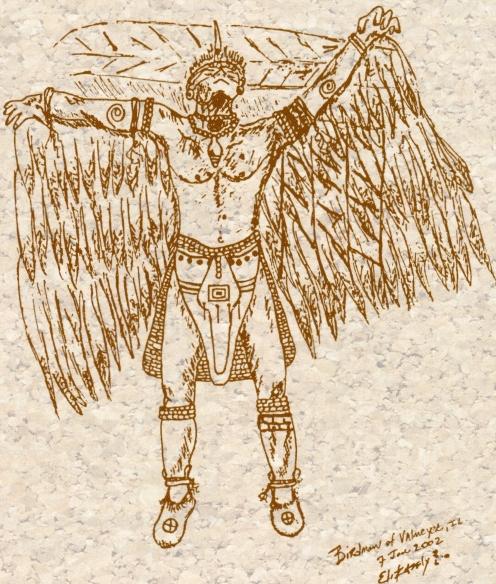
Fantasy Drawing of Kassly Birdman Tablet
Of the many events that happen in one's life, small stories begin. It is by these stories that we are enlightened. Each one of us has a story to tell …
A few months ago, while I was tooling down the road, I drove right into a 'heck of a storm' ! I steered my little black truck into a parking lot and decided to wait it out. As I watched and listened to the rain and the wind and the lightning, I remembered back to another time, a time of the prehistoric American Indians. Their grass and mud caulked huts, sitting out in the elements. The woven cattails on their thatched roofs tearing and thrashing about in a dancing frenzied flurry. As I sat in my truck, it moved and swayed with each burst of energy put out by the storm. How the ancients must have felt, fearful that the great bird would come down from the sky and pluck them from their huts and devour them. Only a cave shelter could protect them now, and a strong will to survive.
Can you envision the Cahokians . . . the Mississippian mound culture people who built their earthen structures to the sky? Can you imagine how these people felt during one of those torrential storms? Lightning and thunder taking its toll on the weak-minded. Just as the storm dies down ... the great Birdman emerges from his water worn lodge high above them all. Shaking rattles made of gourds, he chants to the sky. Would you not fear him and praise him in the same breath? We humans 'fear' what we do not understand.
Raptors were powerful symbols of the sky world. In the upper world, they controlled the sun . . . life! They were the ones that decided whether or not you existed. Who were the people that built the mounds? Who was it that envisioned a great Bird-Man that controlled the people through ritual? In North America, many differences existed among the Indians of the Southeast and the Southwest, but there were also ways in which they were similar. It appears that all of the southeastern Indians as well as some outside the Southeast shared basic assumptions and thought patterns. This includes notions of how the 'cosmos' was put together, as well as very general theories about why things happened. They also shared a fundamental social transformation that began occurring among them at about A.D. 900-1100. Perhaps they were descendants of the great Mayan culture?
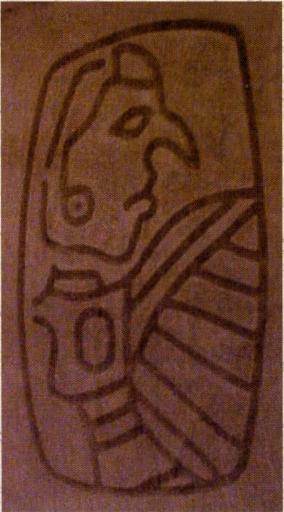
Instead of stone, they incorporated the earth to make their temples.
In southwestern Illinois, just west of the modern day town of Collinsville, is the location of the 1000+ year old prehistoric city we have named `Cahokia'. It is located in the vast flood plains area of the old Mississippi River channels. Here in these bottoms, lie the remnants of the now protected man-made earthen structures. Testing was done on a few of these mounds in the state park during the 1970s under the direction of Melvin Fowler of the University of Wisconsin. While digging a large test trench, near the two eastern lobes at the base of the largest mound (Monk's mound), a small sandstone figural tablet was discovered by one of the workers. Ken Williams picked up the stone ... his heart pounded, as he observed the many rows of two crosshatched lines overlapped on the rectangular shaped stone. As he turned it over… he saw the engraving of a Birdman… half man, half bird, the only representation to be found in good context at Cahokia. This tablet is 4 inches long by 3 inches wide and depicts a masked figure with a diamond eye and a hook nose (a partial mask) and wearing an oval emblem of shell or copper on his chest. His left appendage is that of an outstretched wing. Many stories and perceptions have been proposed for this stone. This icon now represents the prehistoric city of Cahokia Mounds. Its visual reminder can also be seen on the left and right overpasses between I-64 and JB Bridge, Illinois' tribute to the prehistoric Amerindians who once lived below these ancient bluffs of the great Mississippi River Valley.
Could this Birdman stone have been a cult symbol owned by one of the leaders of the People? Perhaps a stone passed down through generations for the purpose of tattoo and/or identification. Maybe to secure immortality or even prestige. The crosshatching on the back of the stone may represent serpent markings or feathers. Similar crosshatched markings are found on depictions of snakes carved on shell cups (associated with human burials) found at Spiro Mounds in Oklahoma. Birdmen are also depicted, as well as an assortment of human forms, animals and plants. Moundville pottery from Alabama depicts crosshatching designs on their winged serpent and bird symbols. A large majority of these vessels also have been associated with burials. Pete Bostrum of Troy, Illinois, once told me, "Art is inspired by something going on at that time." This portable engraved stone was definitely used as either a `visual' communication or a 'spatial' one. The 'art' depicted on these stones attempts to communicate ideas and attitudes within the tribal clans and even into the far outlying villages or 'satellite' communities of the Mississippian people.
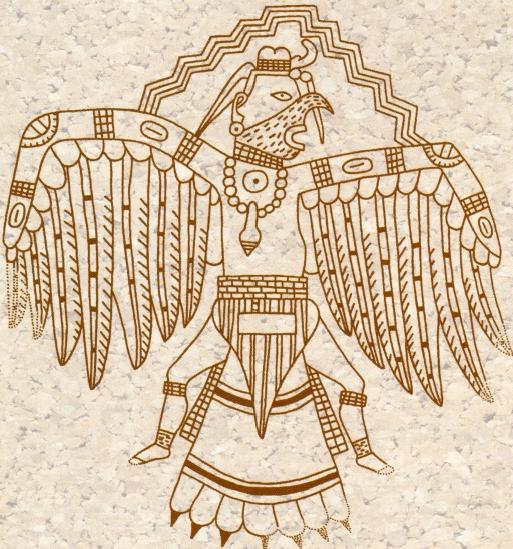
Engraving Found in Spiro Mound
In the same area, just due south of the great Monk's Mound (where Fowler estimated a central post pit would be), were also found the remnants of many burials. Mound 72, barely seven feet high, had turned out to be an enormously complex burial site apparently used for the interment of elite individuals. Central in this group was the Beaded Birdman Burial — an individual who was placed (face up) upon an elaborate platform of 20,000 shell beads arranged in the form of a bird. Later analysis would reveal the burial was actually two males. One individual had been placed under the shell beads face down. This corresponds with the native American belief in dualism that holds that there is a division between the world above and the world below.
Each of us has a vision of the world that belongs to us alone, and when one dies that world dies also. Others may share in some parts of such a vision but none will see it exactly as another does, nor will all experience it in the same way, for each is living with one's own vision of reality. Each person's vision of reality is based upon life experience, the influences of people, places, art and dreams — all the various aspects of one's existence that make up each individual.
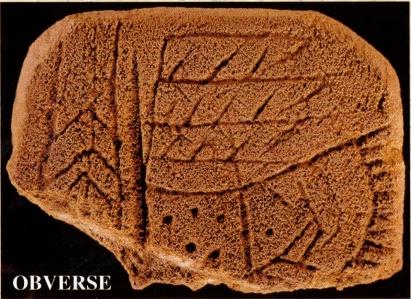
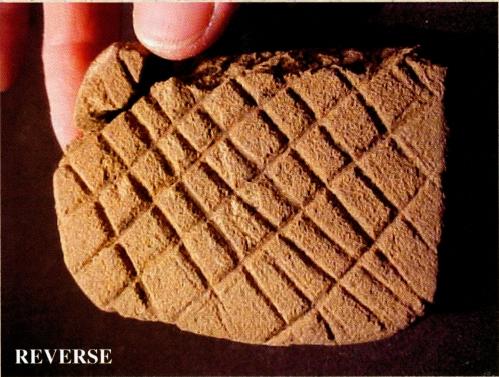
As the years go by, new archaeological evidence of prehistoric humans is found, every day, whether in excavations of proposed highway projects by professionals or discoveries made by individuals in their own back yards. I, myself, enjoy surface collecting in my spare time. On November 15th of 2000, another palm-sized Birdman tablet was discovered in the farm fields along a bluff-base terrace south of old Valmeyer, Illinois, about 40 miles south of Cahokia grounds. It is the first figural tablet known to have been discovered outside of the Cahokia Site. Made of fine grained sandstone, the 2-1/2" x 3-1/2" tablet is known as the Kassly-Schaefer tablet. (As another small piece of it was found on May 11th of 2003.) The Kassly-Schaefer tablet bears an engraved, stylized raptor image that has a slash across the neck portion where the head would have been. Across the top of the tablet (above the slash mark) is a zone of v-shaped lines reminiscent of a timber rattlesnake or a feather. Like the Cahokia Birdman, this figure has one outstretched wing and single angled hatch marks representing feathers. The chest bears two rows of three dots (the edge of the design was broken by the plow). Below its waist, formed by a single line, is a central dot and a triangular apron tied with a sash. The apron appears to be part of a fan shaped tail or a skirt with feathers.
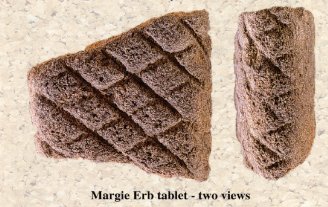
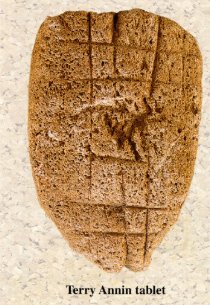
Mississippian-style petroglyphs (images carved in stationary stone) have been found farther south in the surrounding countryside. One is observed to be a headless falconoid figure, with thirteen dots on the chest area and two outstretched wings. In talking with other people (who hunt sites south along the old Illinois River bottom bluffs), I have come across three other possible tablets. A midsection fragment of sandstone tablet found south of Chester, Illinois, by Margie Erb which was donated to Pete Bostrum. It depicts crosshatching on one side and edge, and is plain on the other. A man named Terry Annin, who is a member of the Three Rivers Missouri Archaeological Society, stopped to chat with me one day where I was walking the Birdman fields. In the course of our conversation, I learned that aabout 2 miles south of where the Kassly-Schaefer tablet was found, Terry had found a small 2-3/4" x 1-3/4" sized rectangular shaped piece of limestone with a few squared lines on one side. The front of the piece was pecked or broken off… obliterating any markings that may have been portrayed. Terry was kind enough to let Pete Bostrum photograph and study the tablet. Another bird depiction, on a piece of shaped limestone, was found about 15 years ago by Margie's sister, Mary Mathews. This stone is from the Fenaiai site (a satellite community of Cahokia Mounds), just a short distance to the south of the Kassly-Schaefer tablet site. This stone is a piece of limestone shaped into the form of a bird. It has a similar engraving of the same crouching raptor depicted on both sides of the 1/2 inch thick piece. The eyes are diamond-shaped, and there are crosshatched feathers represented on both sides. The ruffles represented on the legs show clearly that it is a hawk or falcon. Perhaps these stones are 'totems' — objects serving as the emblem of a family or clan and often as a reminder of ancestry.

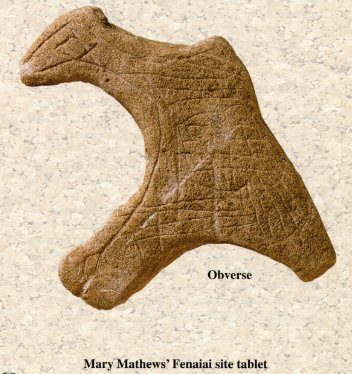
Could these tablets have been used in ceremony at Cahokia? All of the sites in the American Bottoms were apparently political and ritual centers for local Mississippian populations, as evidenced by the discovery of ritual objects, petroglyphs and associated mortuary sites.
While a number of simple crosshatched stone tablets have been found at Cahokia, three others have been found in-situ on Stirling (A.D. 1100) and Moorehead (A.D. 1200) Phase sites excavated in the surrounding area by archaeologists working for the University of Illinois on the 1-255 and I-270 highway projects that took place in the late 1970s and early 1980s. Years ago, a fragmentary piece of tablet was discovered in storage at the Quincy Museum. It was found west of Monk's Mound in 1921. It depicts a partial falconoid figure with an extended leg and talons and appears to be superimposed on a crosshatched background. The Wilson Tablet from Madison County is slightly larger than most of the tablets found. Its depiction is similar to a coiled snake. Three lines in the center splits the design of the lightly incised crosshatching that is done on the same side. The back side is plain. Another tablet was reportedly found around the Horseshoe Lake area near Cahokia Mounds. The stone was broken but the finder was sure there was a Birdman engraved upon it. Unfortunately the tablet was sold to someone from the East Coast many years ago. Maybe someday the buyer will realize what he has and the image will again be seen.
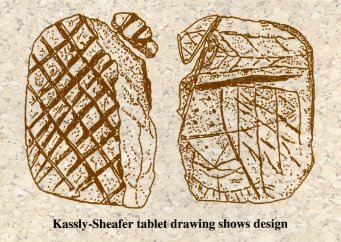
I am sure there have been other tablets found in the surrounding countryside and many more waiting to be found. Just remember, someday you may find something unimaginable. Something that will 'tweak' your brain and cause you to write a story about it. Louis L'Amour mentions in one of his books that, "Knowledge was not meant to be locked behind doors, but to share. It breathes best in the open air where all men can inhale its essence."

REFERENCES
Biloine Whiting Young and Melvin Fowler: CAHOKIA - The Great Native America Metropolis
Brown and Kelly 1999; Cahokia and the Southwestern Ceremonial Complex
Illinois Antiquity (Illinois Association for the Advancement of Archaeology) vol. 36 #2, 2001
Illinois website by Pete Bostrum (www.lithiccastinglab.com) Information on Birdman tablets from Cahokia Mounds and surrounding areas
Philips and Brown: Pre-Columbian Shell Engravings from the Craig Mound at Spiro, Oklahoma, Vol. 1 (plates 68-80)
Charles Hudson: Knights of Spain, Warriors of the Sun
Louis L' Amour: The Haunted Mesa
Jean-Honore Fragonard: The Swing
Duplicated from the “Resources” section of arrowheads.com and reproduced with permission.I keep six honest serving-men (they taught me all I knew); Their names are What and Why and When and How and Where and Who.
- Likes 1
-
Portable Checkerboard Petroglyph
Posted by [CMD]
Tic Tac Toe, anyone? From Norwood, Ma. The rock itself appears unmodified by man and shows no usage, so these are sometimes referred to as "portable petroglyphs". The crosshatch design is in fact a very common design motif in rock art.
The other side shows a few lines:
I keep six honest serving-men (they taught me all I knew); Their names are What and Why and When and How and Where and Who.
Comment
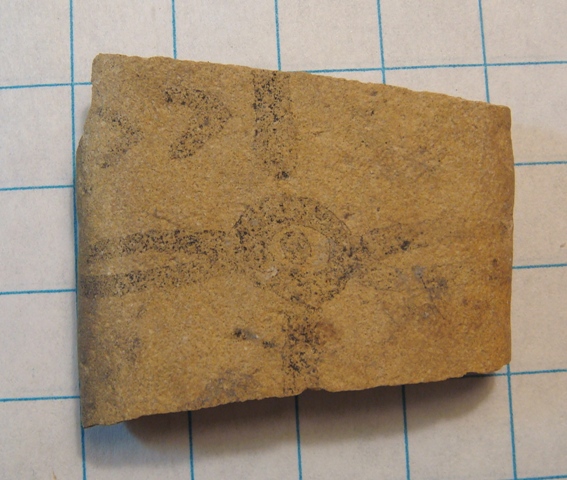
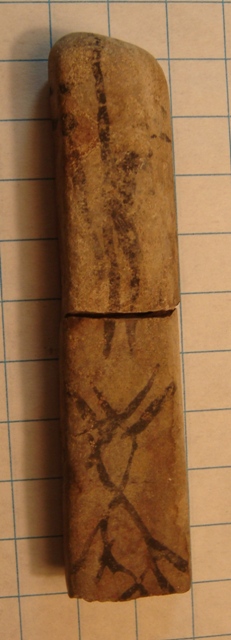
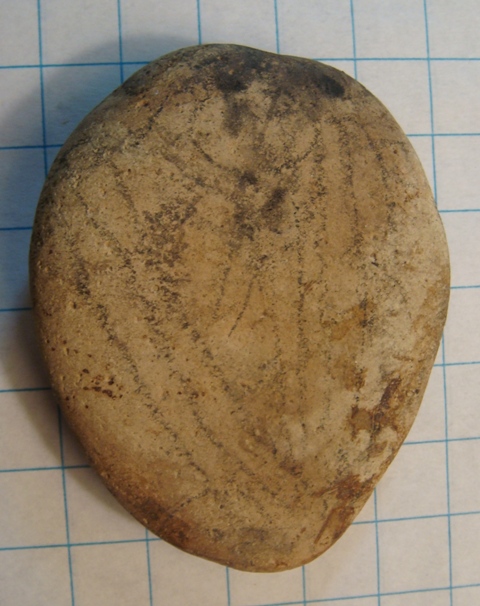
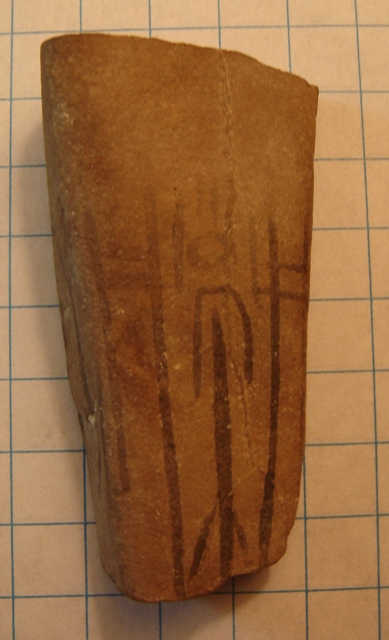
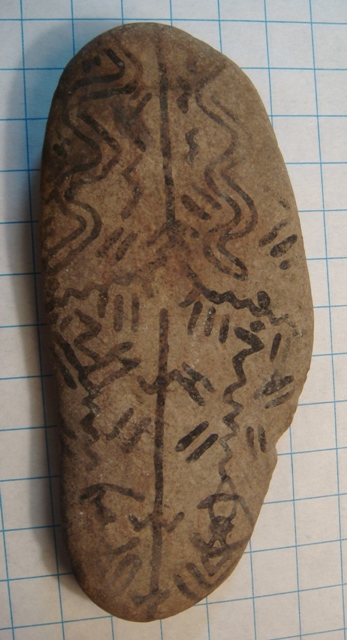
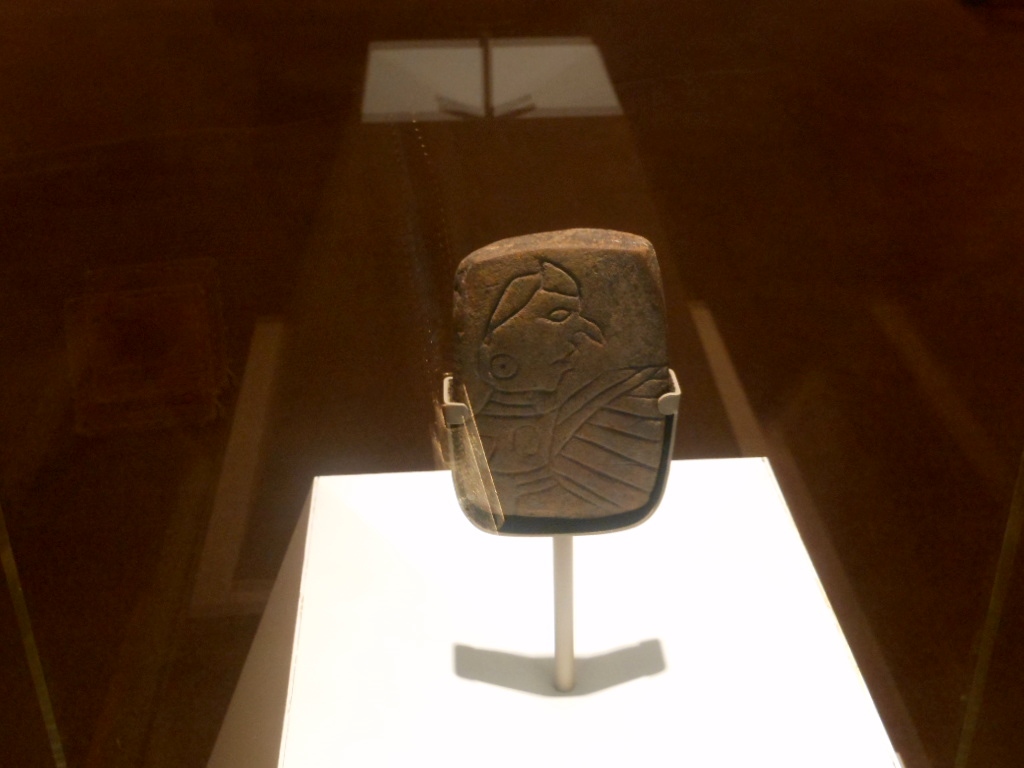

Comment